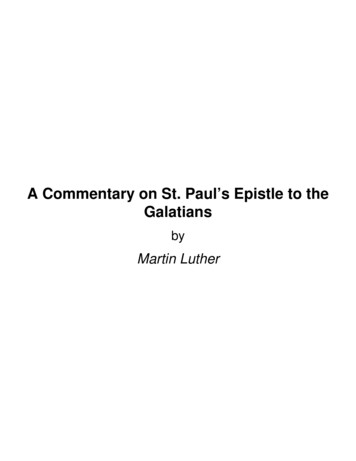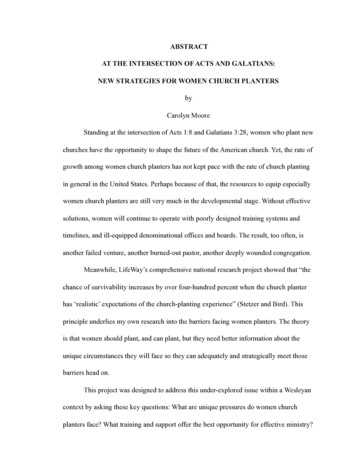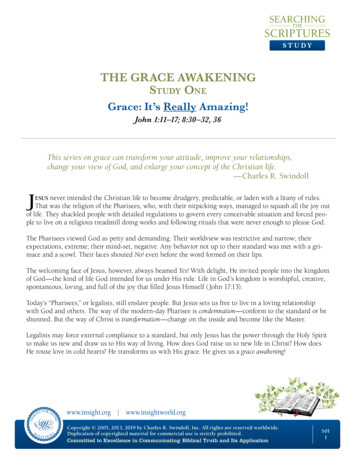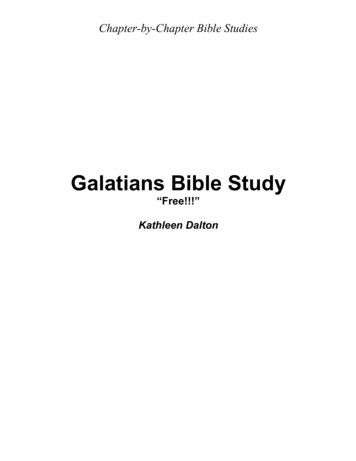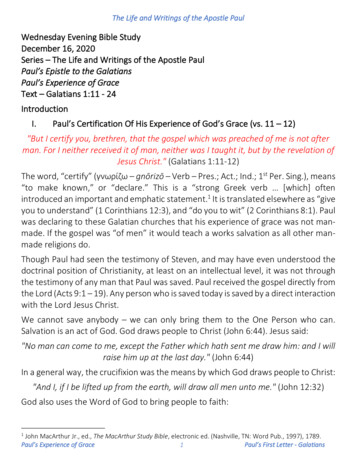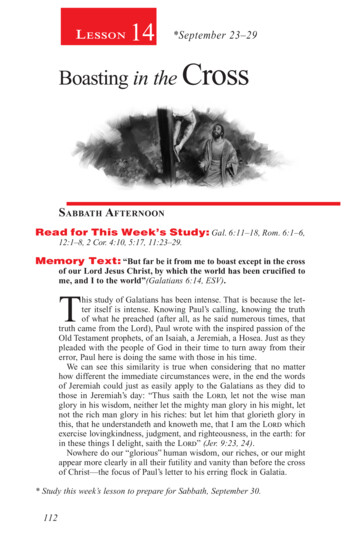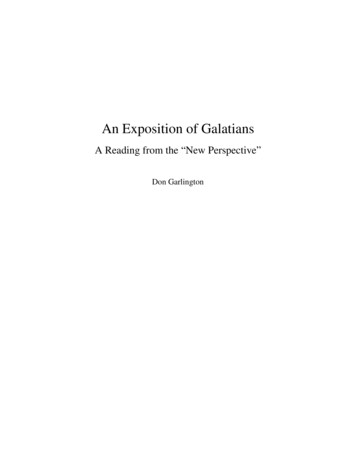
Transcription
An Exposition of GalatiansA Reading from the “New Perspective”Don Garlington
To all those who have listened patient to my lectures on Galatians,and especially to my esteemed teacher and friend,James D. G. Dunn
TABLE OF CONTENTSPrefaceivIntroduction1Galatians Chapter One26Galatians Chapter Two64Galatians Chapter Three110Galatians Chapter Four146Galatians Chapter Five181Galatians Chapter Six220Bibliography246
PREFACEThe present commentary seeks to be a kind of “halfway house” between highly technical andpopular treatments of Galatians. Its purpose is to make the exposition as “user friendly” aspossible with only as many technicalities as necessary to accomplish that end. For this reason,grammatical and textual observations have been kept at a minimum and are mainly confined tothe footnotes, and all Greek and Hebrew words have been transliterated. The emphasis of thework is decidedly theological, with attention focused on the salvation historical argument ofPaul’s letter. I have engaged only a selected portion of the most recent secondary literature,without at all endeavoring to be exhaustive. In a work of this sort, it was my judgment to cite onlyas many sources as necessary to document the various exegetical decisions and to provide thereader with other avenues of information. Since this volume is designed as a study-tool forpastors, missionaries and students, I have distilled, mainly in the section notes, the best ofscholarship that has come to my attention on various points, exegetical, hermeneutical andtheological. For this reason, I have not hesitated to quote at length from those who have gonebefore, particularly when source materials are not readily at hand for many readers. In order to cutto the chase as regards the exposition of the text itself, and to facilitate easier reading, I havelargely refrained from arguing with other points of view, and such argumentation is normallyconfined to the footnotes.Galatians has become even more controversial than ever these days with the advent of the“New Perspective on Paul” in his relation to contemporary Judaism. The present commentaryassumes a modified form of this “New Perspective” as its framework of interpretation, and forthis reason a premium has been placed on the letter’s historical context as attested by theliterature of Second Temple Judaism. It must be added, however, that far from being inimical tothe foundational concerns of the Reformation, the reading of the Galatian letter proffered hereinis fully supportive of the great mottoes of the Reformers themselves: sola scriptura, sola fide,Sola Gratia and especially Solus Christus, and all the more as the present work endeavors tohonor an oft-neglected slogan of the Reformation—ad fontes (“to the sources”).Normally, biblical quotations are from NIV, with others as noted. All abbreviations conformto The SBL Handbook of Style: For Ancient Near Eastern, Biblical, and Early Christian Studies(eds. Patrick H. Alexander, et al. Peabody: Hendrickson, 1999). In the text of the commentary, allsecondary literature is cited by abbreviated titles only, with full information provided by thebibliography.59 Shoredale DriveTorontoOntarioM1G 3T1Canadadongarlington@yahoo.comiv
INTRODUCTIONThe purpose of this introduction is to focus attention on the historical/theological issues thatformed the context of the Galatian letter and gave rise to its issuance on the part of Paul.Questions such as authorship, date, place of writing and destination are of interest in themselves.But apart from authorship, there continues to be uncertainty on all these points, and it is unlikely1that any unanimity will ever be reached (cf. Betz, Galatians, 9-12). Besides, the resolution ofthese issues is hardly indispensable to the interpretation of the epistle’s biblical-theologicalcontent. Discussions can be found in the introductions to each of the commentaries citedthroughout this work, to which I would add, among many others, R. E. Brown, Introduction, 46782; Gorman, Apostle, 183-226; Hansen, DPL, 323-34; Carson/Moo, Introduction, 456-78;2deSilva, Introduction, 493-526; Martin, Foundations, 2.145-58; Guthrie, Introduction, 450-71.Overviews of the theology of the letter can be found in Dunn, Theology of Galatians; Thielman,Theology, 262-75; Marshall, Theology, 209-35; Johnson, Writings, 327-40.Occasion and Purpose of the LetterThe letter to the Galatians mirrors the first major crisis in the life of the infant church. The issue issimply stated: according to Acts 15:1, certain Jewish Christians were insisting that unless Gentileconverts to Christianity are circumcised according to the custom of Moses, they cannot be saved.But this demand on the part of former Pharisees, now reckoned among the Christian community,was extended beyond circumcision to the observance of the whole law of Moses (Acts 15:5; cf.Gal 5:3). In short, according to the “circumcision party,” anyone wishing to join the ranks of thepeople of God from the outside must conform to the normal procedure prescribed for3proselytes—circumcision and commitment to Israel’s Torah.Luke terms this company “believers,” presumably because its adherents accepted Jesus as theMessiah and came to recognize that the age of the Spirit had arrived with him. Nevertheless, infocus and commitment, these people apparently brought their Pharisaic presuppositions over intotheir Christianity. According to that set of assumptions, Israel’s law was eternal and1My inclination is to think that the letter was directed to the churches of South Galatia and dates from c.AD 48-49 (as per Martin, Foundations, 2.151-52).2On Paul the letter writer, see Gorman, Apostle, 74-97 (with further literature); Doty, Letters, 21-47;Roetzel, Paul, 69-92; Cousar, Letters, 23-45; Aune, Environment, 158-82; Stirewalt, Paul; Richards, Paul;Witherington, Paul Quest, 99-115; cf. Stowers, Letter Writing. Methodological questions pertaining to theletter are addressed by Silva, Explorations, and Wright, “Exegesis and Theology.” Galatians has beensubjected to various structural studies, such as Boers, Justification. The broader missionary context ofGalatians is set by Hultgren, Gospel; O’Brien, Gospel; Bolt/Thompson (eds.), Gospel;Köstenberger/O’Brien, Salvation, 161-201; Schnabel, Mission, vol. 2; id., “Israel;” Schnelle, Paul, 111-20;Hofius, “Paulus;” Scott, “Imago Mundi;” id., Paul. Paul’s place within the social and religious setting ofthe Mediterranean world is explored, among many, by Sampley (ed.), Paul; Schnelle, Paul, 57-86, 138-45;Neyrey, Paul and Malina/Neyrey, Portraits. The last two are recommended with some qualification. Seemy “Review Article” of Neyrey’s Paul, along with T. L. Carter’s critique (Paul, 80-86). Numerousrhetorical and historical issues are addressed by Nanos (ed.), Debate. An oft-discussed matter is the relationof Galatians to Paul’s trip to Jerusalem as related in Acts 11:27-30 and especially the “apostolicconference” of Acts 15. See the discussions of Witherington, Grace, 13-20, and Schnelle, Paul, 121-32.The section note to 2:1 likewise offers a reconstruction.3See Schürer, History, 3.150-76; Donaldson, Paul, 54-65.
EXPOSITION OF GALATIANS4unchangeable, and the Messiah himself was conceived of as a servant of the Torah. His job wasto preserve intact the values of God’s covenant with Israel and to eliminate all opposition to the5contrary (as classically affirmed by Psalms of Solomon 17-18).In the Acts narrative, the insistence on circumcision and the law represents the climax of astory, namely, the struggle for Gentile equality in the assemblies of Jesus the Christ. The issue isposed by Boice (Galatians, 409):When the gospel was being preached primarily to Jews by Jews, the development of thechurch progressed smoothly. But as the ambassadors of Christ pushed out into largelyGentile communities and the gospel began to take root there, questions arose regarding aChristian’s relationship to the law of Moses and to Judaism as a system. Was the churchto open her doors wide to all comers, regardless of their relationship to the particularizedtraditions of Judaism? Were her boundaries to be as wide as the human race? Or was sheto be only an extension of Judaism to the Gentiles?By the time the “apostolic conference” of Acts 15 concludes, the apostles and otherparticipants arrive at a consensus: Gentiles are not to be burdened unnecessarily by the Mosaicregulations; they need only abstain from immorality and idolatry (see Witherington, Acts, 46067). Effectively, they said, being Christian does not hinge on first becoming Jewish. Paul’s letterto the Galatians marks the early stages of the controversy. The party whose positions were finallyrejected by the Jerusalem church was actively engaged in missionary activity for a number ofyears. Whatever name it might have borne, it is this same basic group that followed Paul aroundon his travels and attempted to counter his law-free gospel to the Gentiles with its “other gospel”of Christ plus “the works of the law.” For Paul, such a “gospel” was unconscionable, simplybecause “a supplemented Christ is a supplanted Christ” (Hendriksen, Galatians, 112).For Paul, Christ is everything or nothing. Either God has inaugurated the new,eschatological age of the Spirit through Christ, or not. Either justification, or life in theSpirit, is received by faith, or not. Either cruciform faith expressing itself throughcruciform love is the essence of covenantal existence, or not. Either this is all of grace, ornot. Whereas for the circumcisers Christ is necessary but not sufficient, for Paul Christ iseither sufficient or else not necessary (Gorman, Apostle, 216, italics his).4For example, Bar 4:1; 2 Apoc. Bar. 77:15; 1 Enoch 99:2; Wis 18:4; Jub. 1:27; 3:31; 6:17; Josephus, Ag.Ap. 2.277; Philo, Vit. Mos. 2.3, 14. See further W. D. Davies, Torah; Banks, “Role;” Garland, “Defense,”178-79.5Gorman would appear to attribute too much to the circumcisers in writing that they did not deny theimportance of Christ’s death for sins. As we shall see, they were, in point of fact, ashamed of the cross andwould have considered it, in Bruce’s words, a “blasphemous contradiction in terms” (Galatians, 166). Seeon 1:4. However, Gorman is certainly right that their christology was not centered on Christ’s cross but onhis role as a teacher of the law (Apostle, 189-90). Similarly, Hays thinks that the other missionaries didpresumably speak of the cross. But again, it is difficult to conceive that they gloried in it as Paul did. Evenso, Hays is accurate in writing that the opponents did not interpret the cross as the apostle did, as “theapocalyptic termination of the old world of religious symbolism and obligation” (Galatians, 343).2
INTRODUCTION6Much has been written on the identity of the opponents and their theology. But after all issaid and done, Paul’s antagonists in Galatia conceived of themselves as Jewish Christianmissionaries, whose goal was to bring the nations into captive obedience to Israel’s king, in7fulfillment of such OT passages as Ps 2:8 and Gen 49:10. In their view, they were onlyattempting to promote the promise to Abraham of a multitude of descendants by bringingGentiles under the dominion of the law, as supported prima facie by such prophetic texts as Isa82:2-4; Mic 4:1-3; Zech 14:16-19. Galatians, therefore, is Paul’s response to the efforts of theother missionaries to bring Gentiles who have turned to Christ under the dominion of the law, inorder to “complete” their conversion to the God of Israel. Referring to Gal 2:11-21, Garland putsit this way:The incident in Antioch bears witness to the fact that many Jewish Christians sawthemselves as simply a renewal movement within Judaism and regarded newly convertedGentiles as proselytes who needed to be circumcised and to adhere to Jewish mores ifthey were to become fully certified as members of the covenant community (“Defense,”167).As far as these preachers were concerned, faith in Jesus of Nazareth as Messiah is well andgood—this much is fundamental to everything else, because every Jew of the Second Templeperiod knew that the religious life was first and foremost a matter of reliance on God. This axiomof faith in Judaism is amply confirmed by the literature of the predestruction period, which is9replete with references to faith in Yahweh. However, it is equally clear from these sources thatfaith always assumed a nationalistic bias. That is to say, belief in the God of Israel was always tobe accompanied by a steadfast commitment to the Torah, which gave concrete expression to the6For example, Martyn, Galatians, 117-26; Schütz, Anatomy; Howard, Crisis, 1-19; Dunn, Theology ofGalatians, 8-12; Brinsmead, Galatians; Ellis, Prophecy, 80-115, 116-28; Georgi, Opponents; Sumney,Opponents; Gunther, Opponents; Nanos, Irony, 110-92; Calvert-Koyzis, Paul, 86-93; Rapa, Meaning, 8194. Nanos exposes some of the weaknesses of the traditional designations of the group in question.Nevertheless, terms such as “Judaizers,” “circumcision party,” “Jewish Christian missionaries, “othermissionaries,” “opponents,” “rivals,” “antagonists,” “the men from James,” and “Teachers” (Martyn) areretained and used interchangeably. Hays’ objections to “Judaizers” have some basis (Galatians, 185). Yeteven with his qualification of the participants in the Galatians controversy, Paul’s opponents wereendeavoring to compel Gentiles to “live as Jews,” as Peter inadvertently was doing (2:14).7De Boer (“Quotation,” 383, n. 53) prefers to speak of this company as “Christian-Jewish” evangelistsrather than “Jewish-Christian,” because they took their theological point of departure from the Mosaic lawrather than from Christ. Whatever we call them, De Boer is certainly correct in this regard.8The commentary proceeds along the traditional line that Paul’s antagonists were in fact “Jewish Christianmissionaries,” whose conception of the place of the law in the messianic age differed from that of Paul (onthe designation “Jewish Christian,” see Cummins, Paul, 94, n. 1). The thesis of Nanos (Irony) that the“influencers,” as he calls them, were representatives of local synagogues attempting to win the GentileGalatians to non-Christian Judaism is intriguing but hardly convincing. While respecting Nanos’ position,Das rightly concludes that the “they group” in the letter is comprised of Jewish Christians in the Galatians’midst, not non-Christian Jews (Paul and Jews, 17-29). See the further critique of Carson/Moo,Introduction, 465, n. 25.9Garlington, Obedience. Similarly, Schnelle correctly maintains that there existed in ancient Judaism thefundamental conviction that God is merciful, good and loving to his creatures (Paul, 283). Commenting onthe Qumran Hymn Scroll, Schnell writes that the confession of guilt points to dependence on God’srighteousness and mercy, which he will reveal in the judgment. “God’s righteousness leads to obedience tothe law, but without thereby making it a matter of earning merit before God. Rather, God alone grants thedevout assurance of salvation that comes from their belonging to the chosen people” (ibid., 459). Cf. myObedience, 266-67.3
EXPOSITION OF GALATIANSwill of the Lord of the covenant. In brief, the law was given to regulate the life of the believingcommunity, and genuine faith was always sensitive to the “household rules” put in place to guidethe faithful in their walk in the ways of the Lord.Given such a set of assumptions, Paul’s opponents in Galatia were more than glad to have“outsiders” join the ranks of God’s people—but under the proper conditions. Those conditions arewell illustrated by the book of Judith. According to Jdt 14:10, the Gentile Achior believed in theGod of Israel, was circumcised, joined the house of Israel and remained steadfast all his days. Forthese “Judaizers,” it was self-evident that God was ready and willing to receive believers in God’sMessiah; but such faith could never remain alone—it had to be attended by “the works of thelaw” (see on 2:16) in order to be valid. But Paul disagreed, and disagreed vociferously. In light ofwhat God has done in Christ in the fullness of the time (Gal 4:4), the law has served its purpose insalvation history, the dividing wall of hostility between Jew and Gentile has come down (Eph2:14), and God has now received all who place their trust in Christ irrespective of ethnicdistinctives and devotion to the law of Moses. In a nutshell, the only distinction that postdates theresurrection of Christ is faith versus unbelief.By way of an important qualification, however, it should not be supposed that Paul was aMarcionite before Marcion, even though he has some very radical things indeed to say about thelaw in this letter. It is not that he conceives of Israel’s Torah as an evil of some sort. Rather, heseeks to address an attitude that would keep the law around after its goal has been realized—Christ (Gal 3:23-25; Rom 10:4).Paul’s most basic problem with the Law is that it is obsolete and therefore following it isno longer appropriate. It is not the rule of the eschatological age and it is not to beimposed in the new creation which is already coming to be. If Christ came even toredeem Jews out from under the yoke of the Law, if the Law was a pedagogue meant tofunction only until Christ came, if the Law was “set aside” as 2 Cor. 3.11 says, then it is amistake, indeed a serious mistake to go back to keeping it, or in the case of Gentiles tobegin to submit to it in any form or fashion. The Law had an important function and roleto play in the divine economy, but the rule of the Mosaic Law has had its day and ceasedto be. But it is not just the anachronism that bothers Paul about insisting that Christians,whether Jews or Gentiles, must keep the Mosaic Law. What bothers him most is thatkeeping the Law implies in Paul’s mind that Christ’s death did not accomplish what infact he believes it did accomplish. To submit to the Mosaic Law is to nullify the grace ofGod (Gal. 2.21) and to deny that justification or righteousness, whether initial or final,10comes through the death of Christ.deSilva writes to similar effect:Paul’s polemic against “works of the law” is not a polemic against “good works,” asthis is commonly but erroneously understood. Rather, Paul opposes the continuedobservance of a boundary-maintaining code, not only in the observance of the moreobvious differentiators like circumcision, kosher laws and sabbath, but also as an entire10Witherington, Grace, 354. Witherington adds: “We may sum up by saying that for the Christian Paul, theMosaic Law was a good thing, something that came from God, but that it was limited—limited in what itwas intended to and could accomplish, limited in the time-span for which it was meant to be applicable,and limited in the group to which it was meant to be applied (namely Jews and converts or adherents toJudaism). It was but one form of the stoichea [“elements”], and it was something Christ’s coming hadrendered no longer in effect. The people of God were no longer to be under the Guardian now that theeschatological age had broken in and those in Christ could be new creatures and walk in the Spirit” (ibid.,355-56). Such a consideration should temper Schnelle’s assessment that in Galatians the law has norevelatory function and is portrayed in an entirely negative light (Paul, 288-89). For its day, the law didindeed have revelatory value, but that day is past.4
INTRODUCTIONbody of laws given to Israel as a mark of her distinctiveness and separation from theGentiles . It is not in maintaining the ethnic identity of Israel (through such “works ofTorah”) that we are conformed to God’s character or brought in line with God’spurpose, but only through faith in Jesus, which results in the life of the Spirit beingborn in us so that we are born to life before God. Paul certainly expects the Spirit toproduce all manner of “good works” in the life of the disciple (Rom 2:6-11; 6:12-13,Gal 5:13-25, Eph 2:10) (Introduction, 505, n. 9, italics mine).Carrying on from these observations, it follows that the law cannot justify because it wasnever intended to justify. In other words, the inability of the law to justify is rooted ineschatology. There is, one might say, a teleology of the law; that is, its sole reason for being wasto point Israel and all humanity to Christ, in whom God had always purposed to vindicate his11people. In his study of the weakness of the law, Bayes takes issue with the traditional view thatthe law’s inadequacy to justify resides in anthropological failure (the famous suppressedpremise). He rightly maintains that this explanation of the law in Galatians misses the point.For Paul, the law can be described as weak in respect of justification simply because itwas not given by God for the purpose of justification, but rather as an interim provisionpointing forward to the Christ, in whom justification would become a reality. To seekjustification by the law, therefore, as the Galatians were mistakenly trying to do, is toattempt to direct the law towards an end for which it is essentially unsuited by thepurpose of God . Moreover, the power which the law did possess according toGalatians is not its ability to convict of sin, but its epochal purpose as a pointer to12Christ designed to keep God’s people hoping for His coming.The core issue of Galatians thus boils down to a simple but profound choice—Christ or the13Torah. From Romans 14, it is clear enough that Paul was willing to allow Jewish Christians(and others) to practice the law as a matter of personal lifestyle, if they chose. But he drew theline when Torah observance was made the indispensable condition for entering and remainingwithin the people of God. In short, he repudiated the law as the “Jewish gateway to salvation”(Räisänen, Paul, 177-201). At one time, the community of the saved was in fact constituted ofcircumcised and law-observant people. But with the coming of Jesus the Messiah, who himselfbegan to relax the Mosaic strictures (e.g., Matt 8:3; Mark 7:18-19; Luke 7:14; 13:10-17; John5:9b-18), the demand of the Jewish Christian missionaries for circumcision and law-obedience isnot only obsolete, it actually impedes access to God and is tantamount, no less, to idolatry andapostasy (see on 3:10-13; 4:8-10). As Witherington again so aptly puts it:The Gospel of grace proclaims the acceptance and acceptability of both Gentiles andJews on the basis of trust in the faithful work of Jesus Christ which justifies (or sets right)sinners, and not on the basis of works of the Mosaic Law. Therefore works of the MosaicLaw are not merely unnecessary or redundant. If they are pursued by those who areChristians as the proper manner of Christian living, as if Christians were obliged to obeythe Mosaic covenant’s requirements, they amount to a fall from grace, a devaluation ofwhat Christ accomplished on the cross. The origin, character and content of the Gospeldetermines the origin, character and behavior of the people of God, who are Jew andGentile united in Christ and his finished work on the cross (Grace, 90).11Cf. Rappa, Meaning, 167. This is where the term coined by Peter Enns is so helpful. According to Enns,the whole of the OT is “Christotelic” (Inspiration, 154). As regards righteousness, and everything else,Christ is the goal (telos) of the law (Rom 10:4).12Bayes, Weakness, 138. The entire discussion of pp. 125-74 is stimulating and useful.13Gordon, “Problem;” Hubbard, Creation, 199-200.5
EXPOSITION OF GALATIANSAt this juncture, it is important to underscore that the bottom line issue in Galatians issoteriology. Sanders is doubtlessly correct to maintain that “Paul’s argument is not in favor offaith per se, nor is it against works per se. It is much more particular: it is against requiring theGentiles to keep the law of Moses in order to be ‘sons of Abraham’” (Paul, the Law, 19). He addsfurther that “we have become so sensitive to the theological issue of grace and merit that we oftenlose sight of the actual subject of the dispute” (ibid.). Thus, the subject of Galatians is “thecondition on which Gentiles enter the people of God” (ibid., 18). Nevertheless, much more is atstake than a sociology or group identity, one enclave distinguishing itself from another. If thetopic under discussion is “how to enter the body of those who would be saved,” then “the topic is,in effect, soteriology” (ibid., 45, 46). Cousar speaks to the same effect: “The issue under debate,raised by the agitators’ demand for circumcision, was basically soteriological, how God saves14people” (Galatians, 61). See Acts 15:1.This affirmation of soteriology as lying at the root of Galatians is a necessary corrective to N.T. Wright’s otherwise excellent treatment of justification and righteousness language in the Paul.Wright maintains that justification and, consequently, the subject matter of Galatians, does nottell one how to be saved; it is, rather, a way of saying how one can tell that one belongs to the15covenant community, or, in other words, How does one define the people of God? To be sure,such issues are to be judged in light of the covenant context of “the righteousness of God” andsimilar ideas. On this, Wright is undoubtedly correct, and in this regard the ensuing exposition ismuch in his debt. Indeed, Galatians does address the question, “Who is a member of the people ofGod” (Paul, 121). Likewise, it is true that “justification, in Galatians, is the doctrine which insiststhat all who share faith in Christ belong at the same table, no matter what their racial differences,as together they wait for the final new creation” (ibid., 122).This much said, it must be countered that Wright has constructed a seemingly falsedichotomy between the identity of the people of God and salvation. It is closer to the mark to saythat Galatians does have to do with entrance into the body of the saved, meaning that to belong to16the new covenant is to belong to the community the of saved. Therefore, justification doesindeed tell us how to be saved, in that it depicts God’s method of saving sinners—by faith in17Christ, not from works of the law—and placing them in covenant standing with himself. Ifjustification is by faith, then in point of fact a method of salvation is prescribed: one enters into18the realm of salvation by faith.It is just because the bedrock of Galatians is soteriology, and it is just because Paul seesdefection from Christ to the law as taking place “so quickly” in the Galatian congregations that hewrites with an intense awareness of the plight of his “children” in the gospel who are in danger offorsaking their Lord for what effectively is no better than their former bondage to pagan deities14All this is seconded by Hubbard (Creation, 200). However, Hubbard mistakenly relegates the unity of thepeople of God in Galatians to a topic of secondary status.15Wright, Paul, 119, 120-22, 131; id., Perspective, 122.16In this regard, Hafemann is correct in insisting that the context of Paul’s usage of “works of the law” isthe contrast between the two covenant eras within the history of redemption, not (merely, I would say) amaterial or socio-ethnic contrast. “Hence, to continue to maintain allegiance to the old covenant once thenew has arrived not only denies the saving efficacy of Christ’s work, but also leads at times to a falseboasting and ethnically based ‘legalism’ [I prefer “nomism”] as a by-product” (“Spirit,” 178, n. 24).17I am setting aside the traditional rendering of “by works of the law” in favor of “from works of the law,”for reasons to be clarified in the commentary on 2:16 and subsequent passages.18A very telling consideration is that “righteousness” and “salvation” are placed in synonymous parallel inpassages in the Prophets and the Psalms. See on 2:16.6
INTRODUCTION(4:8-10). In plain terms, the letter is written to avert the apostasy in Galatia. No wonder, Paul’spassions are white hot in this letter.Todd Wilson’s study of the apostasy motif in Galatians is brilliant and significant in manyregards. Wilson begins with the question of J. L. Martyn, What time is it (see below)? Instead ofpursuing this issue as such, he poses a related question, Where are the Galatians? That is to say,what is their current position vis-à-vis the beginning and end of their pilgrimage of faith. Hisanswer is that they are in the wilderness, somewhere between Egypt and the promised land. Butthe problem is that they, like the Israel of old, are in danger of forsaking the Lord and returningtheir old master. In particular, Wilson develops the apostasy/idolatry theme in relation to theissues of freedom and bondage. His conclusion is:After having been miraculously delivered from servitude through an Exodus-likeexperience in Christ (1.4; 3.13; 4.4-5; 5.1), the Galatians are now contemplating areturn to Egyptian-like bondage. Paul is at pains, therefore, to exercise whatevermoral leverage he can over the situation, thus colouring his rebukes and warningswith language that evokes the Israelites’ own tragic wilderness defection and19disinheritance.The Message of the Opponents and Paul’s ReplyApart from what can be reconstructed respecting the presuppositions of the other teachers fromhistorical sources, we are dependent on Paul himself for information about his opponents’positions. Although there are limitations to the method, any interpretation of Galatians inevitably20resorts to a certain amount of “mirror reading” of the text. That is to say, judging from whatPaul actually writes about his antagonists, certain factors can be deduced, running the wholegamut from the certain to the incredible (Barclay, “Mirror Reading,” 265-66). Whilecommentators will continue to debate the precise demands made on the Galatians by the JewishChristian missionaries, in the main these are not so difficult to discern. Nor is Paul’s replydifficult to determine. As Gorman writes, Pau
Witherington, Paul Quest , 99-115; cf. Stowers, Letter Writing . Methodological questions pertaining to the letter are addressed by Silva, Explorations , and Wright, "Exegesis and Theology." Galatians ha s been subjected to various structural studies, such as Boers, Justification . The broader missionary context of
